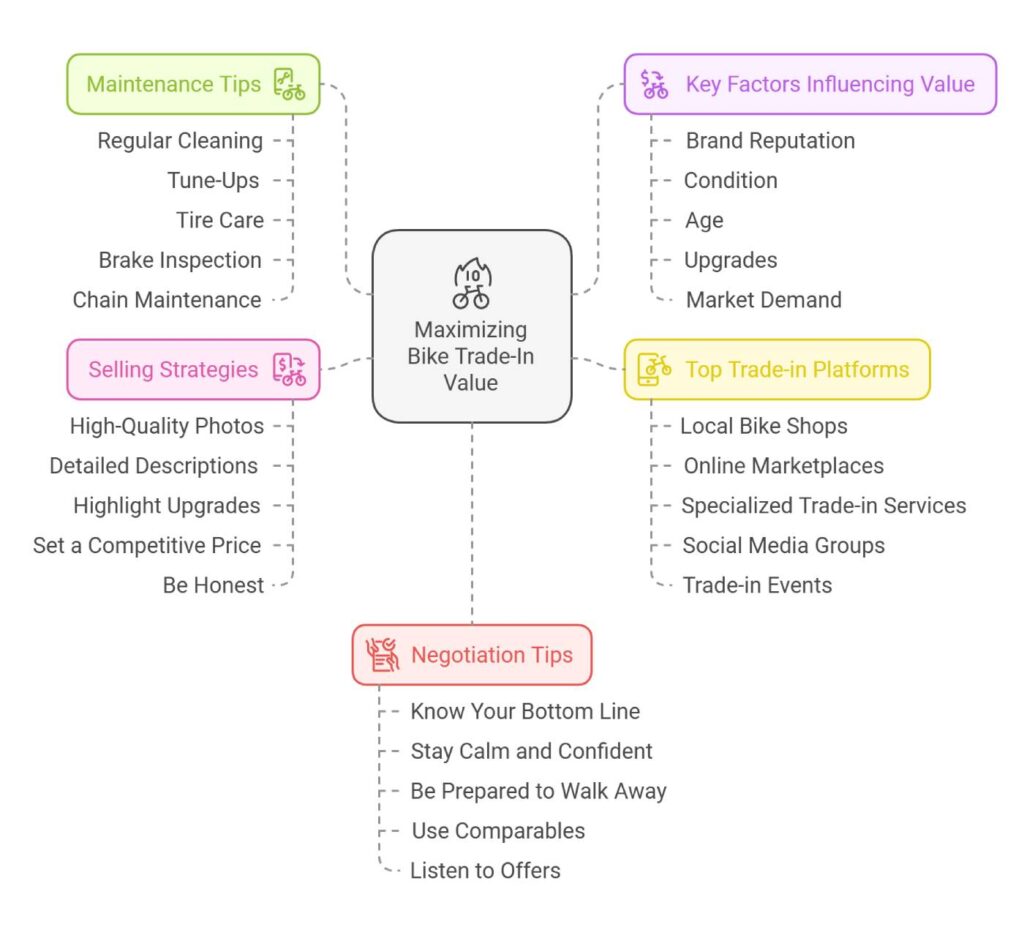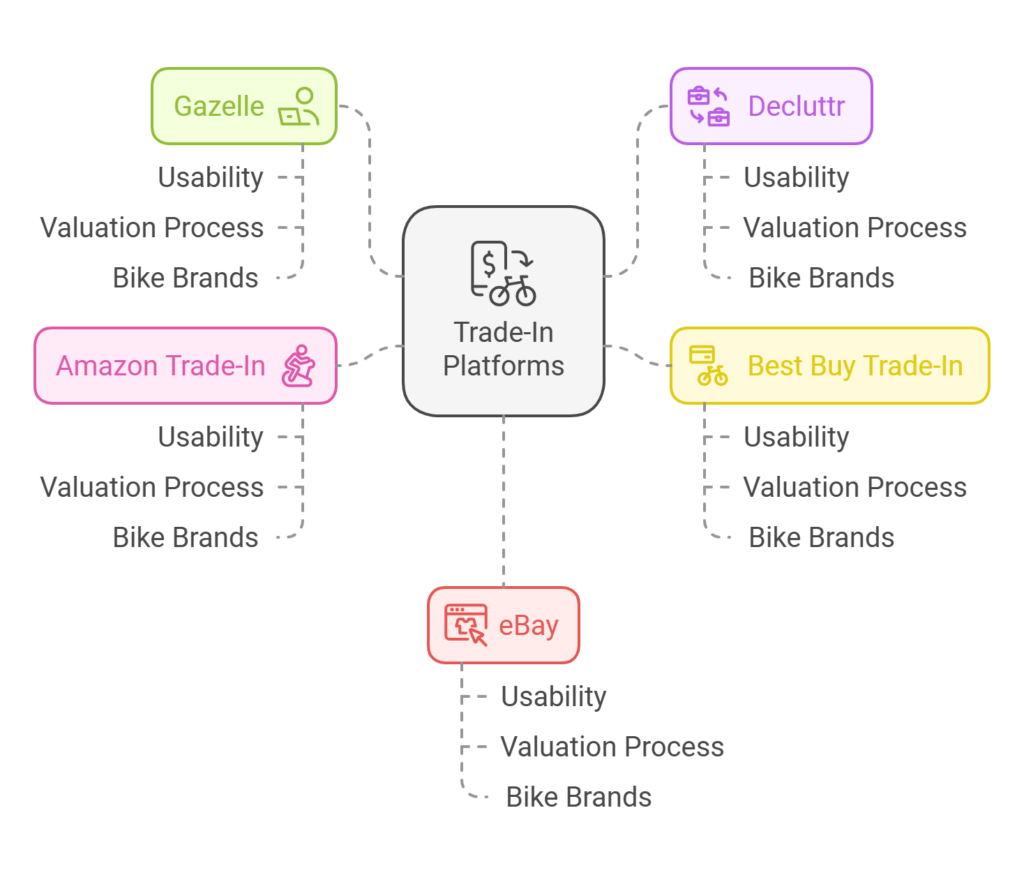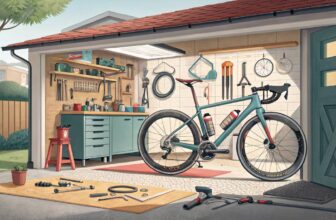Thinking about upgrading your ride but unsure how much your current bike is worth? You’re not alone. Navigating the world of bike trade-ins can feel like tackling a steep hill, especially for first-timers.
Whether you’re looking to cash in or simply make a smart swap, understanding your bike’s trade-in value is crucial. From maintaining impeccable records to choosing the right platform, we’ve got the roadmap to maximize your payout.
Let’s pedal through the essentials to ensure you get the best deal possible when trading in your trusty two-wheeler.
Understanding Trade-in Value
Swapping your trusty bicycle for a new ride ain’t a walk in the park. For first-timers or those not in the know about the ins and outs of its worth, it can feel a bit like riding uphill. Getting a grip on these concepts helps you gear up to get the most bang for your buck.
Importance of Maintenance Records
Keeping tabs on maintenance records is as vital as bread’s butter when figuring out a bike’s trade-in worth, kind of like how cars are treated. These records show investors you’ve been good to your bike, proof it’s well-fed and healthy. Make sure you’ve got records of:
- Regular Tune-ups: Document those routine pit stops at the bike shop.
- Component Replacements: Collect receipts for major swaps like the chain, tires, and brake pads.
- Upgrades: Log any performance boosters, whether it’s a snazzy new saddle or slick handlebars.
Factors Influencing Bike Value
A bunch of different things can affect how much you get for your old wheels. Knowing these can help you make sure your bike is in tip-top shape for trade-in.
- Brand and Model: Fancier brands and popular models usually get you more cash. For the scoop on top names, check out our best bike brands guide.
- Age and Condition: A seasoned bike in prime shape can sometimes outshine a newer, banged-up one. Regular tune-ups and quick fixes keep the value up.
- Type of Bike: The resale value varies for road, mountain, and hybrid bikes. Different folks, different strokes, and this can sway trade-in deals. See the variety here.
- Original Retail Cost: How much that bike originally cost is a big clue about its trade-in worth. The pricier ones tend to hold a chunk of their value longer.
- Market Trends: Seasons and sales push around demand and values. Bike worth might sway with holiday sales or prime cycling times. Peek at our when to buy bike article for more on these swings.
- Upgrades and Customizations: Adding some flair can boost value, but going overboard might scare off buyers. Keep upgrades practical like new gears or brakes, and save the bling for later. More on this in our bike component comparison guide.
| Factor | Impact on Value |
|---|---|
| Brand and Model | High |
| Age and Condition | High |
| Type of Bike | Varies by Segment |
| Original Retail Cost | Significant |
| Market Trends | Variable (Seasonal) |
| Upgrades and Customizations | Mixed (Depends on Buyer Preference) |
Getting savvy with these can clue you in on your bike’s value and set you up for better deals. For more insight, check out the Bicycle Blue Book and our bike brands comparison. Keeping your bike at the tip-top of its game can jack up its trade-in value and your payout. Check out our advice on documenting bike condition and giving it some TLC.

Trade-in Options
Swapping out your old bike for something shiny and new can be a smart move if you know the ropes. Let’s break down your options, focusing on the Trek Bikes Trade-in Program and how to sell your used wheels like a pro.
Trek Bikes Trade-in Program
Thinking about trading in your bike for a new one? Check out Trek’s plan. If you’ve got a Trek that’s less than 10 years old and worth over $150, they’ll spruce it up and put it on their Red Barn Refresh list—a fancy name for their certified pre-owned bikes. If your ride isn’t a Trek but still clocks in at over $400, it’ll find a new home through Bicycle Blue Book. Other bikes ultimately head to local charities.
What’s the catch? You get store credit to use on the spot for a new bike. The credit you get depends on what the store manager thinks, using the Bicycle Blue Book as a guideline.
Here’s a quick look:
| Bike Type | How Old? | Minimum Value | Destination |
|---|---|---|---|
| Trek | Up to 10 years | Over $150 | Refreshed in Red Barn |
| Non-Trek | Any | Over $400 | To the Blue Book |
| Everything Else | Any | Any | Goes to Charity |
Want more on what your bike’s worth? Check out our bike price guide.
Selling Strategies for Used Bikes
If the Trek Plan’s not your cup of tea, you’ve got other ways to flip that old bike. Perfect for bikes that don’t make the cut or are just a bit older than you’d like.
Where to sell:
- Facebook Buy/Sell/Trade Groups: Perfect for making deals with neighbors.
- Bike Classifieds: Tap into a crowd that knows their gears from their chains.
- Craigslist: Cash in on those quick, local sales.
- The Pro’s Closet: These guys pay well with either store credit or cash in your PayPal.
Before you hit sell, check out the Bicycle Blue Book. Need to dive deeper into bike selling secrets? Our used bike inspection guide is just a click away.
What to mull over:
- Brand Buzz: Big names can mean big bucks.
- Under the Hood: Well-looked-after bikes bring more.
- What’s Hot and What’s Not: Some models fly out the door if there’s a buzz.
For more on new bikes vs oldies, scoot over to our new vs used bike comparisons. Fancy yourself a haggle expert? Visit our how to negotiate bike price guide.
Picking the right trade path can really pump up your payout. Get savvy with these tips and give your trade-in the boost it deserves!
Determining Bike Worth
Figuring out what your bike’s worth is a big deal when you’re thinking of trading it in. The Bicycle Blue Book and checking out your bike’s brand and age hold the key to nailing its market value and getting the most out of trade-in offers.
Bicycle Blue Book Assessment
The Bicycle Blue Book is like the crystal ball for used bikes. By throwing in bits like the bike’s year, brand, model, and condition, it spits out an estimate of what your bike’s worth. Consider this a solid starting place for trade-in talks.
Big names like Trek Bikes and The Pro’s Closet lean on the Bicycle Blue Book to set the store credit for a trade-in, making it a trusted resource.
Here’s how a bike’s condition shakes up its value in the Bicycle Blue Book:
| Condition | Estimated Value (% of Original MSRP) |
|---|---|
| Excellent | 75% – 90% |
| Good | 60% – 75% |
| Fair | 40% – 60% |
| Poor | 10% – 40% |
Evaluating Bike Brand and Age
Your bike’s brand and age have a massive say in its value. High-end names like Specialized, Trek, and Cannondale fetch better prices because they’re known for quality and cutting-edge performance. The Pro’s Closet is on the hunt for top-notch road, mountain, TT, triathlon, cyclocross, gravel, and E-bikes from recent years, highlighting how critical brand and age are.
The Pro’s Closet targets bikes originally priced at $1500 or more from recent models. It keeps its collection top-tier and full of value.
Here’s what impacts a bike’s worth:
| Factor | Impact on Value |
|---|---|
| Brand (e.g., Trek, Specialized) | Higher resale value due to solid reputation |
| Age (years since buy) | Newer models tend to score higher value |
| Type of bike (road, mountain, etc.) | Popular types usually rack up a higher price |
| Original retail cost | The higher the original price, the better the trade-in deal |
Before you swap your bike, use this info to get a solid idea of its value. The Bicycle Blue Book and knowing your bike’s brand and age can help you cruise through trade-in options and snag the best deal. For tips on boosting your bike’s trade-in value, peek at our bike price guide and where to buy bikes.
Understanding these points is key for first-time bike buyers, those upgrading, and anyone wanting a sweet trade-in deal. Thinking of a new bike? Check out our guide on new vs used bikes.
Trade-in Platforms
Checking out trade-in platforms can help those bike aficionados looking to get the most green for their gear and make selling a breeze.
The Pro’s Closet Trade-in Process
The Pro’s Closet (TPC) rolls out a pretty sweet gig for cyclists wanting to trade their rides. They’re known for dropping solid offers within 48 hours — all based on real-world market insights and what’s hot that season. You get paid either with store credit or cold hard cash through PayPal.
| Feature | TPC Trade-in Process |
|---|---|
| Offer Time | Within 48 hours |
| Payment Methods | Store credit, PayPal cash |
| TradeUp System | Available |
| Item Condition | Required to be in good working order |
Just a heads up though, those values aren’t set in stone. They might adjust the offer if your bike ain’t in tip-top shape or is missing a thing or two.
TPC’s got this cool TradeUp system where local bike shops cut you a deal by letting you trade your old wheels for credit on new ones. Easy peasy. Dive deeper into bike trade-in values right here on our site.
Utilizing Pinkbike BuySell and Local Groups
Pinkbike BuySell is like a hallowed ground for mountain bikers and dirt track daredevils. It’s an ace spot for both online and local deals, hooking up sellers right with the peeps who want what they’ve got.
What perks of using Pinkbike BuySell? Take a peek:
- Massive community of bike lovers
- Listings where you can get into the nitty-gritty with bike specs
- Haggling directly with buyers is totally cool
Local joints like Facebook Marketplace, bikers’ clubs, or cycling shindigs are also buzzing with folks on the hunt for second-hand gear, offering a speedy route to closing that sale.
To ace it on these platforms, keep this in mind:
- Describe bike status: Be upfront about the bike’s condition, pointing out any bumps or bruises. Snag some stellar pics and craft detailed descriptions.
- Know your numbers: Check out Bicycle Blue Book to hit the right price point and dodge lowballers.
- Be ready to roll with it: Expect some dickering over price and stay open to tweaking your ask.
Curious about scoring bikes or rocking those trades? Stumble upon more gems in our articles on where to buy bikes and successful bike trade-in tactics.
By playing the game with these platforms and pointers, sellers can score top dollar for their bikes and connect with buyers lickety-split.
Maximizing Trade-in Value
Thinking about trading in your bike and getting a sweet deal? The trickiest part boils down to two key things: keeping your ride in tip-top shape and playing it smart with those trade-in offers. Get these right, and you’ll be smiling all the way to the bank.

Preserving Bike Condition
How your bike looks and runs can make or break your trade-in value. Take care of it, and you might just see those dollar signs add up.
Regular Maintenance
- Cleaning: Get into the habit of giving your bike a good scrub. Dirt’s like sandpaper for your ride; it’ll slowly eat away at your parts if you’re not careful.
- Lubrication: Keep those chains and gears slick. A drop of oil now and then keeps everything moving smoothly and lowers the wear and tear.
- Routine Checks: Peek at the brakes, tires, and gears on the regular. Fix little problems before they turn into big headaches.
Jotting down all those check-ups and tune-ups does wonders. Do you know how people like seeing a car’s service history? Bikes are no different. If you’re curious about how all this impacts value, swing by our bike price guide.
| Maintenance Activity | Frequency |
|---|---|
| Cleaning | After every ride |
| Lubrication | Every 100 miles |
| Brake Inspection | Monthly |
| Tire Inspection | Before every ride |
Interior and Exterior Condition
- Frame: Keep it shiny and dent-free. A dab of touch-up paint does wonders for those little scratches.
- Components: Check out those handlebars, saddle, and pedals. Make sure they ain’t wobbly or worn out.
- Storage: When you’re not out riding, stash your bike in a dry spot. That’ll keep rain and rust far, far away.
Want more tricks of the trade? Peek at our used bike inspection write-up.
Negotiating Trade-in Offers
Negotiation is king when it comes to snagging a great trade-in deal for your bike.
Research and Preparation
- Know Your Bike’s Worth: Use things like the Bicycle Blue Book for rough estimates. Check out Femme Cyclist; they break down the nitty-gritty of brand, age, type, and what the bike originally cost.
- Prepare Maintenance Records: Flipping through your bike’s history book? That’s what’ll tip the scale in your favor during talks.
Effective Communication
- Highlight Positive Features: Brag a bit! That new gear shift, fancy brand, or top-notch condition deserves some spotlight time.
- Be Willing to Walk Away: Don’t bite at the first bait. If it ain’t a fair price, pack it up and check out other places—like The Pro’s Closet—for better offers.
For some golden words on negotiation, check our negotiate bike price blurb.
By zeroing in on bike upkeep and sharpening those negotiation skills, anyone from the newbie to the pro can squeeze the best value out of their trade-in. Looking for more cool insights? Dive into our guides on new vs used bikes and where to buy bikes online.

Tips for Trade-in Success
Trading on a bicycle doesn’t have to be a headache. With some preparation and savvy strategies, you can easily increase its trade-in value. Here’s how to get the best bang for your buck.
Maintenance Tips for Higher Value
Prior maintenance is like a love note to your bike; it keeps showing in its value as you sell. Here’s how to keep that two-wheeler in tip-top shape.
Keep Detailed Maintenance Records
Think of it as a car’s service log but for your bike. These records paint a picture of a well-loved, well-kept ride. Keep track of everything from tire alignments to brake tweaks. Want to know more? Check out our documenting bike condition write-up.
Maintain a Clean Bike
It’s ain’t just about looks! A clean bike can tell buyers it’s been taken care of. Regular baths rid it of road grit and grease. Make sure your frame’s got that showroom shine, too.
Inspect and Replace Worn Components
Parts like tires and chains wear down over time. Swap out those past-their-prime pieces to keep performance sharp. Our bike maintenance plans can keep you on track with a replacement schedule.
Ensure Proper Storage
Store that beauty in a dry place where rain can’t mess it up. Using a cover while it’s idle helps preserve its looks and function.
Strategies for Successful Trade-ins
Here’s how to transform your bike into a hot commodity, ensuring you don’t just offload it but actually get a good deal.
Research Trade-in Values
Get savvy with your pricing by consulting resources like the Bicycle Blue Book. Being in the know lets you haggle like a pro.
Pre-Sell Your Bike’s Features
Think your ride’s all that? Prove it. Talk up any sweet upgrades or special touches. Unique components or mods can add serious cred.
Negotiate Smartly
Negotiation is an art. Arm yourself with research, point out those standout features, and know when to dig in your heels or ease off. Want more tips? Take a peek at our negotiating bike price guide.
Choose the Right Platform
Different trade-in spots come with different perks. Check out places like The Pro’s Closet Trade-in Process or Pinkbike BuySell to see which aligns with your goals.
Prepare Documentation
Paperwork can be a pain, but it smooths the trade process. Gather receipts and neat maintenance records to boost your offer.
By keeping these tips in your back pocket, you’ll retain your bike’s value and make it irresistible to potential new owners. Maximize returns and make trading stress-free. For more on making the most of your bike sale, head over to guides on when to buy a bike, new vs used bikes, and bike ownership transfer.
Conclusion
Maximizing your bike’s trade-in value is a blend of diligent maintenance, strategic planning, and savvy negotiation.
By keeping meticulous maintenance records and ensuring your bike is in pristine condition, you signal to potential buyers that your ride has been well cared for. Understanding the influence of brand, model, and market trends allows you to position your bike effectively in the resale market.
Whether you choose to leverage specialized trade-in programs like Trek’s or explore broader platforms such as Facebook and Craigslist, each avenue offers unique advantages to suit your needs. Additionally, honing your negotiation skills ensures you secure the best possible payout, turning your old bike into a valuable asset for your next adventure.
Remember, a little preparation goes a long way in transforming your trade-in experience from daunting to rewarding. Equip yourself with these insights, and ride confidently towards a profitable trade-in deal.
Frequently Asked Questions
What factors most influence my bike’s trade-in value?
Brand, model, age, condition, and maintenance records are the key factors that determine your bike’s trade-in value. High-end brands and well-maintained bikes typically fetch higher prices.
How can I prepare my bike for trade-in to get the best value?
Ensure your bike is clean, perform necessary maintenance, gather all maintenance records, and consider minor upgrades that enhance functionality without overspending.
Which platforms offer the best trade-in deals for bikes?
Programs like Trek’s Trade-in Program and The Pro’s Closet provide reliable trade-in options, while platforms like Facebook, Craigslist, and Pinkbike BuySell offer broader selling opportunities.
Do I need to have all my bike’s original parts to maximize its trade-in value?
While original parts can enhance value, functional and upgraded components can also boost your bike’s appeal. It’s important to maintain a balance between originality and performance upgrades.
How does the Bicycle Blue Book assess my bike’s value?
The Bicycle Blue Book evaluates your bike based on its brand, model, year, condition, and any upgrades, providing an estimated resale value to guide your trade-in negotiations.
Final Thoughts
Trading in your bike doesn’t have to be a complex or stressful process. With the right knowledge and preparation, you can turn your old bike into a valuable asset for your next cycling adventure.
Remember to keep your maintenance records up-to-date, maintain your bike in excellent condition, and choose the right platform that aligns with your trade-in goals. Whether you opt for a specialized trade-in program or explore broader selling avenues, each option offers unique benefits tailored to different needs.
Don’t underestimate the power of effective negotiation and presenting your bike’s best features. By following these expert strategies, you not only enhance your trade-in value but also ensure a smooth and rewarding transaction.
Ready to make the most out of your bike trade-in? Gear up with our comprehensive guides and step confidently into your next cycling chapter.
Key Tips
- Maintain Detailed Records: Keep all maintenance and upgrade receipts to prove your bike’s upkeep.
- Keep It Clean: Regularly clean your bike to preserve its appearance and functionality.
- Upgrade Wisely: Invest in practical upgrades that enhance performance without overspending.
- Choose the Right Platform: Select trade-in options that best match your bike’s brand and condition.
- Research Before Selling: Use resources like the Bicycle Blue Book to understand your bike’s market value.
- Negotiate Confidently: Be prepared with data and highlight your bike’s best features during negotiations.
Recommended Biking Products and Accessories
- Bike Maintenance Kit: Includes essential tools for regular upkeep.
- High-Quality Bike Cleaner: Keeps your bike spotless and well-maintained.
- Chain Lubricant: Ensures smooth gear transitions and prolongs drivetrain life.
- Upgraded Saddle: Enhances comfort and performance.
- Performance Tires: Improves ride quality and bike longevity.
- Bike Storage Cover: Protects your bike from the elements when not in use.
- Maintenance Logbook: Helps you keep detailed records of all bike services and upgrades.
- Multi-Tool for Bikes: Essential for on-the-go adjustments and repairs.
- Durable Bike Lock: Secures your bike when trading it in or selling.
- Portable Bike Pump: Ensures your tires are always ready for the road.




